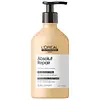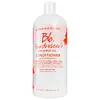What's inside
What's inside
 Key Ingredients
Key Ingredients

 Benefits
Benefits

 Concerns
Concerns

 Ingredients Side-by-side
Ingredients Side-by-side

Water
Skin ConditioningCetearyl Alcohol
EmollientDicetyldimonium Chloride
EmulsifyingCetrimonium Chloride
AntimicrobialDimethicone
EmollientCetyl Esters
EmollientSodium Benzoate
MaskingIsopropyl Alcohol
SolventAmodimethicone
Linalool
PerfumingTrideceth-10
CleansingTartaric Acid
BufferingHexyl Cinnamal
PerfumingChlorhexidine Digluconate
AntimicrobialLimonene
PerfumingPEG-100 Stearate
Phenoxyethanol
PreservativeSteareth-6
EmulsifyingTrideceth-3
EmulsifyingChenopodium Quinoa Seed Extract
Skin ConditioningCI 19140
Cosmetic ColorantAcetic Acid
BufferingHydroxypropyltrimonium Hydrolyzed Wheat Protein
Skin ConditioningTrisodium Hedta
CI 17200
Cosmetic ColorantParfum
MaskingWater, Cetearyl Alcohol, Dicetyldimonium Chloride, Cetrimonium Chloride, Dimethicone, Cetyl Esters, Sodium Benzoate, Isopropyl Alcohol, Amodimethicone, Linalool, Trideceth-10, Tartaric Acid, Hexyl Cinnamal, Chlorhexidine Digluconate, Limonene, PEG-100 Stearate, Phenoxyethanol, Steareth-6, Trideceth-3, Chenopodium Quinoa Seed Extract, CI 19140, Acetic Acid, Hydroxypropyltrimonium Hydrolyzed Wheat Protein, Trisodium Hedta, CI 17200, Parfum
Water
Skin ConditioningCetearyl Alcohol
EmollientCetyl Esters
EmollientGlycerin
HumectantButyrospermum Parkii Butter
Skin ConditioningBehentrimonium Chloride
PreservativeVitis Vinifera Seed Oil
EmollientPrunus Amygdalus Dulcis Oil
Skin ConditioningMacadamia Integrifolia Seed Oil
Skin ConditioningCocos Nucifera Oil
MaskingGardenia Taitensis Flower Extract
Skin ConditioningArgania Spinosa Kernel Oil
EmollientCarthamus Tinctorius Seed Oil
MaskingHydroxypropyltrimonium Hydrolyzed Corn Starch
Hydrolyzed Vegetable Protein Pg-Propyl Silanetriol
Skin ConditioningHydrolyzed Wheat Protein
Skin ConditioningHydrolyzed Wheat Starch
Skin ConditioningDimethicone
EmollientSodium Hyaluronate
HumectantGlyceryl Stearate Se
EmulsifyingPanthenyl Ethyl Ether
Sodium PCA
HumectantEthylhexylglycerin
Skin ConditioningDimethiconol
EmollientPantethine
EmollientPotassium Stearate
CleansingSodium Chloride
MaskingCitric Acid
BufferingParfum
MaskingLinalool
PerfumingHexyl Cinnamal
PerfumingBHT
AntioxidantDisodium EDTA
Tocopherol
AntioxidantPhenoxyethanol
PreservativePotassium Sorbate
PreservativeWater, Cetearyl Alcohol, Cetyl Esters, Glycerin, Butyrospermum Parkii Butter, Behentrimonium Chloride, Vitis Vinifera Seed Oil, Prunus Amygdalus Dulcis Oil, Macadamia Integrifolia Seed Oil, Cocos Nucifera Oil, Gardenia Taitensis Flower Extract, Argania Spinosa Kernel Oil, Carthamus Tinctorius Seed Oil, Hydroxypropyltrimonium Hydrolyzed Corn Starch, Hydrolyzed Vegetable Protein Pg-Propyl Silanetriol, Hydrolyzed Wheat Protein, Hydrolyzed Wheat Starch, Dimethicone, Sodium Hyaluronate, Glyceryl Stearate Se, Panthenyl Ethyl Ether, Sodium PCA, Ethylhexylglycerin, Dimethiconol, Pantethine, Potassium Stearate, Sodium Chloride, Citric Acid, Parfum, Linalool, Hexyl Cinnamal, BHT, Disodium EDTA, Tocopherol, Phenoxyethanol, Potassium Sorbate
Ingredients Explained
These ingredients are found in both products.
Ingredients higher up in an ingredient list are typically present in a larger amount.
Cetearyl alcohol is a mixture of two fatty alcohols: cetyl alcohol and stearyl alcohol. It is mainly used as an emulsifier. Emulsifiers help prevent the separation of oils and products. Due to its composition, it can also be used to thicken a product or help create foam.
Cetearyl alcohol is an emollient. Emollients help soothe and hydrate the skin by trapping moisture.
Studies show Cetearyl alcohol is non-toxic and non-irritating. The FDA allows products labeled "alcohol-free" to have fatty alcohols.
This ingredient is usually derived from plant oils such as palm, vegetable, or coconut oils. There is debate on whether this ingredient will cause acne.
Due to the fatty acid base, this ingredient may not be Malassezia folliculitis safe.
Learn more about Cetearyl AlcoholCetyl Esters is a synthetic wax made up of mostly fatty acids and fatty alcohols. It is strcturally similar to wax taken from whales.
As an emollient, it creates a thin barrier on the skin. This barrier prevents moisture from escaping.
This ingredient may not be fungal-acne safe.
Learn more about Cetyl EstersDimethicone is a type of synthetic silicone created from natural materials such as quartz.
What it does:
Dimethicone comes in different viscosities:
Depending on the viscosity, dimethicone has different properties.
Ingredients lists don't always show which type is used, so we recommend reaching out to the brand if you have questions about the viscosity.
This ingredient is unlikely to cause irritation because it does not get absorbed into skin. However, people with silicone allergies should be careful about using this ingredient.
Note: Dimethicone may contribute to pilling. This is because it is not oil or water soluble, so pilling may occur when layered with products. When mixed with heavy oils in a formula, the outcome is also quite greasy.
Learn more about DimethiconeHexyl Cinnamal is a fragrance ingredient with a similar scent to jasmine. It can be naturally found in chamomile essential oil.
This ingredient is a known EU allergen and may sensitize the skin. The EU requires this ingredient to be listed separately on an ingredients list.
Hexyl Cinnamal is not water soluble but is soluble in oils.
Learn more about Hexyl CinnamalLinalool is a fragrance and helps add scent to products. It's derived from common plants such as cinnamon, mint, citrus, and lavender.
Like Limonene, this ingredient oxidizes when exposed to air. Oxidized linalool can cause allergies and skin sensitivity.
This ingredient has a scent that is floral, spicy tropical, and citrus-like.
Learn more about LinaloolParfum is a catch-all term for an ingredient or more that is used to give a scent to products.
Also called "fragrance", this ingredient can be a blend of hundreds of chemicals or plant oils. This means every product with "fragrance" or "parfum" in the ingredients list is a different mixture.
For instance, Habanolide is a proprietary trade name for a specific aroma chemical. When used as a fragrance ingredient in cosmetics, most aroma chemicals fall under the broad labeling category of “FRAGRANCE” or “PARFUM” according to EU and US regulations.
The term 'parfum' or 'fragrance' is not regulated in many countries. In many cases, it is up to the brand to define this term.
For instance, many brands choose to label themselves as "fragrance-free" because they are not using synthetic fragrances. However, their products may still contain ingredients such as essential oils that are considered a fragrance by INCI standards.
One example is Calendula flower extract. Calendula is an essential oil that still imparts a scent or 'fragrance'.
Depending on the blend, the ingredients in the mixture can cause allergies and sensitivities on the skin. Some ingredients that are known EU allergens include linalool and citronellol.
Parfum can also be used to mask or cover an unpleasant scent.
The bottom line is: not all fragrances/parfum/ingredients are created equally. If you are worried about fragrances, we recommend taking a closer look at an ingredient. And of course, we always recommend speaking with a professional.
Learn more about ParfumPhenoxyethanol is a preservative that has germicide, antimicrobial, and aromatic properties. Studies show that phenoxyethanol can prevent microbial growth. By itself, it has a scent that is similar to that of a rose.
It's often used in formulations along with Caprylyl Glycol to preserve the shelf life of products.
Water. It's the most common cosmetic ingredient of all. You'll usually see it at the top of ingredient lists, meaning that it makes up the largest part of the product.
So why is it so popular? Water most often acts as a solvent - this means that it helps dissolve other ingredients into the formulation.
You'll also recognize water as that liquid we all need to stay alive. If you see this, drink a glass of water. Stay hydrated!
Learn more about Water